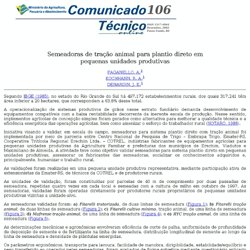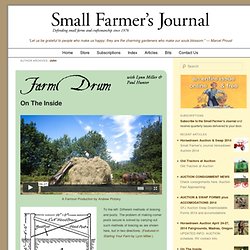

Planet junior seeder « between ourselves and our land. June 17, 2012 by Chandler One of Joel’s projects lately has been procuring and setting up our straddle row cultivator with Planet Jr.

Seeders. We’ve already done our dry bean and corn seedings with a Earthway Seeder this year, but we still had to plant our flint corn, a popular multi-colored open pollinated variety called Painted Mountain, so after a test run a couple weeks ago, we finally prepared section for corn and got out the seeders. The already dusty sandy soil had been dried out before planting, which wasn’t ideal but it wasn’t clumpy or very trashy with grass clumps so the seeders glided along well. One of the potential downsides is that the seeders are in line with the horses steps, so as you can imagine, the seeder shoes are moving through uneven soil, at times even coming out of the soil completely in holes where the horses stepped.
Found on Craigslist, Joel picked these up out of an old barn. Like this: Like Loading... Semeadoras de tração animal para plantio direto em pequenas unidades. Segundo IBGE (1985) , no estado do Rio Grande do Sul há 497.172 estabelecimentos rurais, dos quais 317.241 têm área inferior a 20 hectares, que correspondem a 63,8% desse total.

A operacionalização de sistemas produtivos de grãos nesse estrato fundiário demanda desenvolvimento de equipamentos compatíveis com a baixa rentabilidade decorrente da inerente escala de produção. Nesse sentido, implementos agrícolas de concepção simples foram gerados como alternativa para melhorar a qualidade técnica e a eficiência energética das operações agrícolas, bem como amenizar o esforço do trabalhador rural ( NOTARO, 1988 ). As validações foram realizadas em uma pequena unidade produtiva representativa, mediante participação ativa de extensionistas da Emater-RS, de técnicos da COTREL e de produtores rurais. As semeadoras foram reguladas para distribuir 55 sementes aptas de milho para cada 10 metros de linha de semeadura. Mulching Roller for Development : TILLERS INTERNATIONAL. Rolcut Knife-Roller : Animal Traction. Machinery In 1991, when we started our first experiences and began thinking about developing modern machinery for draft animals, we met Charlie Pinney.

Charlie was a pioneer in animal traction in Europe, an exceptional and extremely helpful person. Several times we spoke with him about the problems of modern machinery. It was at that time that we saw, for the first time, a forecart with pto drive, still without on-board motor and Charlie explained us the limits of these machines. The limits are imposed by the adherence between the drive wheels and the ground. Implements such as mowers, for example, are hard to get operating properly with this type of forecart. We too, having built this type of forecarts, founded ourselves facing these sorts of problems. By that we abandoned this solution and devoted ourselves to other types of machinery. We built a manure spreader, a model like those coming from the United States as well as a hay-loader used to gather loose hay. Permanent Farming Systems based on Animal Traction: PART III Draft animal implements: 3.9 The seed planter. Small Farmer's Journal. This article was originally published in the Summer 2012 (Vol. 36, No. 3) issue of Small Farmer’s Journal.

All photos are from Natural Roots Farm except for the last, which is from Cedar Mountain Farm. by Anne & Eric Nordell of Trout Run, PA Thanks to the many apprenticeship programs, field days, conferences, websites and publications available in the new millennium, it is relatively easy for new and transitioning farmers to learn the business of small-scale organic vegetable production. Economic models of horse-powered market gardens, however, are still few and far between. To fill that information hole, I asked three experienced farmers to join me in tracking work horse hours, expenses and labor over a two-year period and to share the results in the Small Farmer’s Journal. When I initiated this horse accounting project in the winter of 2010, I had several goals in mind. The cost of working the horses ranged from $3 to $17 per horse hour. . - Paul Hauser - David Fisher. ADABio Autoconstruction - La coopérative des savoirs paysans.